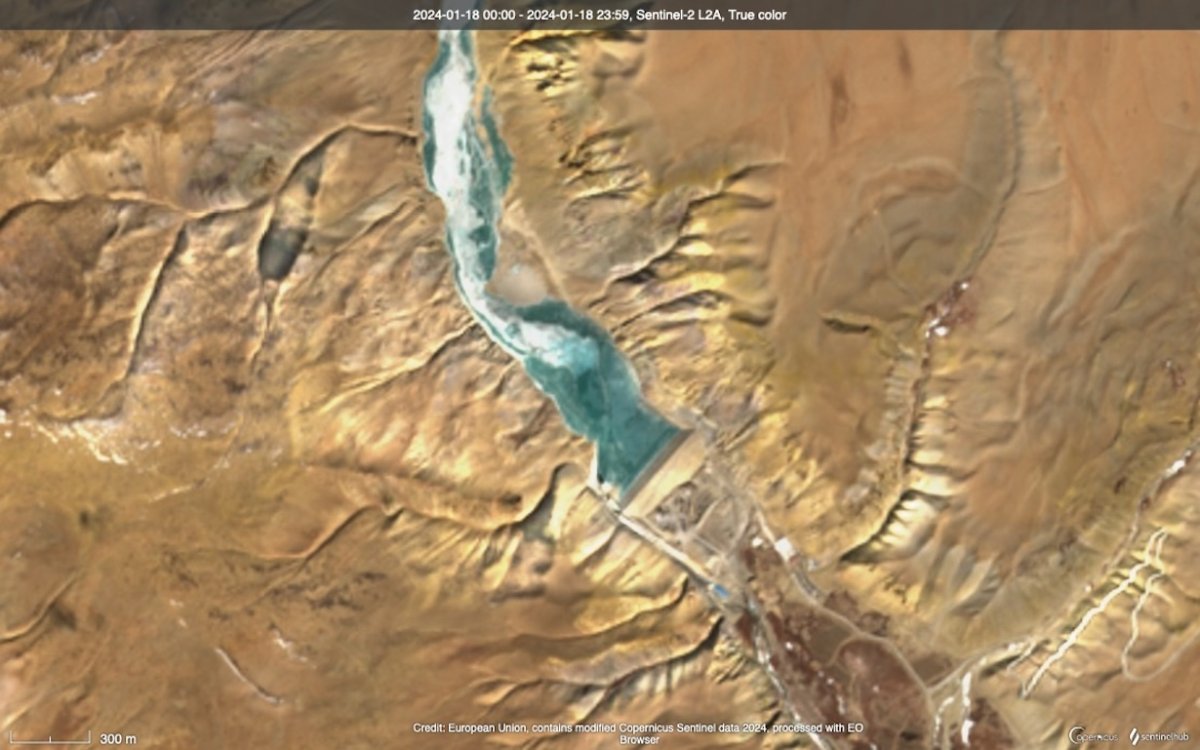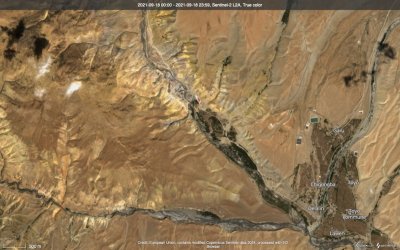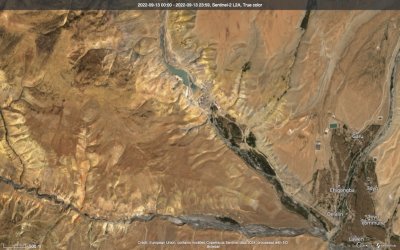China appears to have completed the construction of a new dam in the country's southwestern border regions, a project that could have far-reaching strategic implications for its southern neighbors India and Nepal, according to new satellite imagery.
Mapcha Tsangpo River, which translates from Tibetan as "peacock," is known as the Ghaghara in India and the Karnali in Nepal. It is a significant and perennial source of freshwater water supply to the populations in western Nepal and in the India's northern plains.
Beijing and New Delhi have sparred over China's dam building in the Himalayas before, including since the start of construction at the Yarlung Tsangpo river three years ago. The mega-dam project involves the world's highest major river, which begins in China's southwestern Tibet Autonomous Region and flows into India as the Brahmaputra.
Newsweek's analysis of imagery from Sinergise's Sentinel Hub website, which renders photographs captured by the Sentinel-2 satellite of the European Union's Copernicus earth observation program, found construction at Mapcha Tsangpo began in July 2021.
The dam north of the town of Burang, in Tibet's Ngari prefecture, is now complete and visible in images taken this month from Earth orbit.

The concrete structure is roughly 18 miles north of Nepal's border town of Hilsa and approximately 37 miles east of the Indian border. Hilsa has roughly 51,000 residents, but Nepal's wider western region is home to more than 4 million people.
New dams coming up in the upper reaches of the Himalayas could impact the lives of millions in India who live in neighboring areas on the Nepalese border.
Downstream from Nepal, Mapcha Tsangpo enters the plains of India, where it is known as the Sarayu, and passes through Ayodhya in the northern state of Uttar Pradesh. The city is considered the birthplace of the Hindu god Ram.
On Monday, Prime Minister Narendra Modi presided over the "Pran Pratishtha" consecration ceremony at the culturally and politically significant Hindu temple.
China's additional infrastructure in its sensitive border regions includes the new Ali Pulan Airport, a dual-use site that serves both civilian and military purposes, which officially became operational late last month, according to the Tibet region's civil aviation authority.




"India is naturally concerned about the potential long-term repercussions of Chinese activities for decades. Understanding China's hydro-behavior with other neighbors is crucial in deciphering its hegemonic approach that has gone unchecked as of now," said Sana Hashmi, a postdoctoral fellow at the Taiwan-Asia Exchange Foundation think tank in Taipei.
Beijing in 2017 stopped sharing hydrological information with New Delhi, only to later renew the data-sharing contract at a cost. Previously, in 2013, when then-Prime Minister Manmohan Singh visited Beijing, the two governments signed a memorandum of understanding wherein China committed to sharing hydrological data with India annually from May 15 to October 15, Hashmi told Newsweek.
"Despite the existence of an MOU to share flood data for the Brahmaputra during the monsoon season, there is not much progress," she said.
Omair Ahmad, managing editor for South Asia at The Third Pole, a specialist publication on environmental issues in the Himalayan region, told Newsweek that the case of the new dam in Tibet had shades of China's hydropolitics in the Mekong Delta of Southeast Asia.
"The best comparison of this is how China has tried to reshape hydropolitics in the Mekong. This is where it has increasingly argued that, as an upstream neighbor, it has rights that the downstream neighbors must respect, which goes completely against all of the international law on this," Ahmad said.
"It's not simply that the water flows through an upstream and that the upstream riparian doesn't have absolute rights over a river. There is the downstream riparian that has usage rights based on traditional usage," he said.
Ahmad added: "Unlike the Mekong, there are no regional water institutions like the Mekong River Commission in South Asia, so there is not even a space to engage."
The Chinese, India and Nepalese foreign ministries did not immediately return written requests for comment before publication.
A 2022 investigation by Indian news website The Quint said China had charged India over $19 million for data from three hydrological stations. Last fall, Hong Kong's South China Morning Post said the two governments were renegotiating the hydrological data-sharing agreement, which expired in 2023.
In 2019, Li Keqiang, China's late former premier, spearheaded a follow-up project to the South-to-North Water Diversion Project, an ambitious decades-long plan to transfer resources from the water-rich Three George Dam on the Yangtze River to the country's arid northern regions including Beijing and Tianjin.
That project went into "full construction" this month, according to China's official news service Xinhua.
In 2021, China announced plans to link Tibet's river systems with the rest of the mainland, which would involve building a mega dam along the border areas with India.
The project at Yarlung Tsangpo, the fifth longest river in China, is another sticking point in China-India relations for its strategic potential to control freshwater access to the downstream Brahmaputra. The river located in the east of their long and disputed border is one of the most critical sources of fresh water for the inhabitants of India's northeastern region as well as in Bangladesh.
Mark Giordano and Anya Wahal, experts at Georgetown University's Walsh School of Foreign Service, argued in December 2022 that the water of the Brahmaputra could become a source of conflict between the two Asian giants.
"The Brahmaputra would appear to be at the top of the list of conflict hotspots. The river is shared between four states, including the world's two most populous, China and India. Both have rapidly growing economies, and both are already among the most water-stressed in the world," they wrote for the United States Institute of Peace.
In recent years, India has protested China's construction of hydropower projects by refusing to purchase electricity from sites with Chinese investment, such as the Chameliya hydropower station in Nepal, built with Beijing's financial aid.
Beijing is building yet another dam north of the Burang site, construction for which began in December 2022, according to Xinhua. The project could further control Tibet's river system upstream from the Mapcha Tsangpo.
"The total storage capacity of the reservoir is 4.0352 million cubic meters. The project development task is mainly for irrigation," China's state media said at the time.
Uncommon Knowledge
Newsweek is committed to challenging conventional wisdom and finding connections in the search for common ground.
Newsweek is committed to challenging conventional wisdom and finding connections in the search for common ground.
About the writer
Aadil Brar is a reporter for Newsweek based in Taipei, Taiwan. He covers international security, U.S.-China relations, and East Asian ... Read more
To read how Newsweek uses AI as a newsroom tool, Click here.








